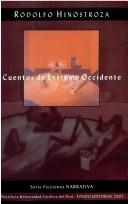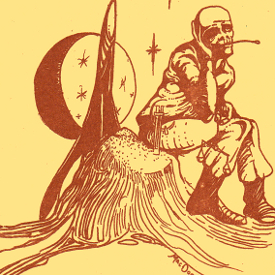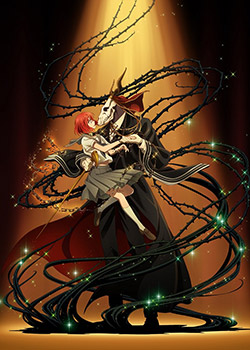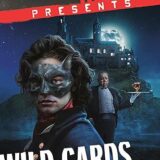 Circumstance plays a part in history. It was inevitable that a woman would eventually try her hand at Sword & Sorcery. It’s our good fortune that C. L. Moore was writing for Weird Tales in the 1930s. Leigh Brackett would have been the next logical choice, but she didn’t rise to prominence until the 1950s, when Fantasy magazines were about as abundant as members of the Communist Party of America. Moore had two great series in Weird Tales: the first, was the space operas of Northwest Smith and his sidekick Yarol.
Circumstance plays a part in history. It was inevitable that a woman would eventually try her hand at Sword & Sorcery. It’s our good fortune that C. L. Moore was writing for Weird Tales in the 1930s. Leigh Brackett would have been the next logical choice, but she didn’t rise to prominence until the 1950s, when Fantasy magazines were about as abundant as members of the Communist Party of America. Moore had two great series in Weird Tales: the first, was the space operas of Northwest Smith and his sidekick Yarol.
But even better were her five tales of the Lady of Joiry, Jirel. What Moore brought to the series was a new and intriguing feel to Fantasy. The readers of Weird Tales dubbed Jirel ‘gal Conan’ in the letter columns but this largely because what else did they have to compare it to? Inspired by A. Merritt and his language-rich fiction of the first decade of the 20th century, tales like “Through the Dragon Glass” (1917) and “People of the Pit” (1918) have more in common with Moore’s Jirel. Even Francis Stevens’ novel The Citadel of Fear (1918) seems a closer match in tone. Moore created a darkly “weird” landscape of gods and other beings that are both fascinating as well as creepy. Where Howard’s Hyboria is a step-child to historical adventure, Jirel is closer to the horror story, closer to Howard’s Kull stories.
“Black God’s Kiss” (Weird Tales, October 1934) and “Black God’s Shadow” (Weird Tales, December 1934) are really two halves one story. Guillaume and his army takes Joiry. The conqueror savages the Lady Jirel who escapes with the help of a priest. She enters a dark realm to find the black god. Jirel seeks a terrible revenge on Guillaume. In the sequel she realizes the sin of this act is too great and she must free Guillaume’s spirit. (The rape motif will become a cliché trope for much S&S featuring women characters. Marion Zimmer Bradley attacks the issue openly in the introduction to her first Sword & Sorceress anthology in 1984).
“Jirel Meets Magic” (Weird Tales, July 1935) finds Jirel the pursuer this time, following the wizard Giraud into a strange land ruled by a sorceress named Jarisme. Jirel is forced to defeat the witch and her god to get at Giraud. This story is perhaps the most like A. Merritt’s work.
“The Dark Land” (Weird Tales, January 1936) has Jirel dimension traveling because of a pike wound. There she finds a powerful being named Pav who would wed her. Jirel buys time and meets the former lover of Pav who gives her the way to destroy him.
 A collaboration with future husband, Henry Kuttner, was called “Quest of the Starstone” (Weird Tales, November 1937). This tale paired up Jirel with Moore`s other famous character, Northest Smith. The sorcerer Franga (Jirel does seem to have issues with sorcerers!) has lost his magical starstone to the Lady of Jirel and seeks revenge. To do this he brings Northwest Smith out of time and space to defeat her. As with any good guy versus good guy tale, they of course hook up and take on Franga. This tale is largely a NW Smith story and Moore never included it in the Jirel volume.
A collaboration with future husband, Henry Kuttner, was called “Quest of the Starstone” (Weird Tales, November 1937). This tale paired up Jirel with Moore`s other famous character, Northest Smith. The sorcerer Franga (Jirel does seem to have issues with sorcerers!) has lost his magical starstone to the Lady of Jirel and seeks revenge. To do this he brings Northwest Smith out of time and space to defeat her. As with any good guy versus good guy tale, they of course hook up and take on Franga. This tale is largely a NW Smith story and Moore never included it in the Jirel volume.
“Hellsgarde” (Weird Tales, April 1939) is the most horror-oriented of the Jirel tales. Jirel enters a haunted castle to find a treasure to pay a ransom for her soldiers. In the castle she encounters a strange family that feasts on the undead.
 Leigh Brackett in her introduction to Sword Woman (1979), tells that Howard was fond of the Jirel stories. His own Red Agnes may have taken a little inspiration from her. This opinion of Howard’s is interesting for REH did not share his little franchise in Fantasy the way H. P. Lovecraft did with his Mythos fiction. It is only after Howard’s death that imitators come along. This says to me that he didn’t see her as an imitator, and I would agree. Moore does her own thing. In fact, she inspired a second line of Sword & Sorcery, one that would ultimately lead to Red Sonja more than any character of Howard’s. What she also did was at the start (1934) tell all those that followed that there was another way to write a heroic fantasy tale.
Leigh Brackett in her introduction to Sword Woman (1979), tells that Howard was fond of the Jirel stories. His own Red Agnes may have taken a little inspiration from her. This opinion of Howard’s is interesting for REH did not share his little franchise in Fantasy the way H. P. Lovecraft did with his Mythos fiction. It is only after Howard’s death that imitators come along. This says to me that he didn’t see her as an imitator, and I would agree. Moore does her own thing. In fact, she inspired a second line of Sword & Sorcery, one that would ultimately lead to Red Sonja more than any character of Howard’s. What she also did was at the start (1934) tell all those that followed that there was another way to write a heroic fantasy tale.











Recent Comments